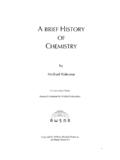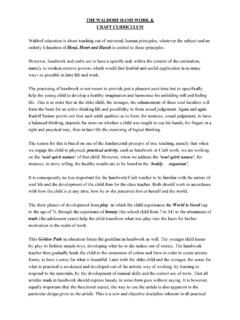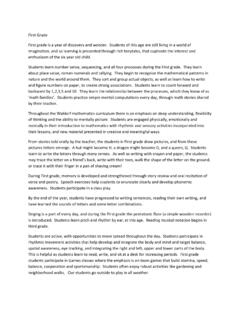Transcription of Science in Education - Waldorf Research Institute
1 Science in Education PrefaceOut of print reference books are often difficult to locate. Through the foresight and support of the Waldorf curriculum Fund, this title has been resurrected and is now available gratis in an electronic version on , one of the websites of the Research Institute for Waldorf Education . We hope you will find this resource valuable. Please contact us if you have other books that you would like to see posted. David MitchellResearch Institute for Waldorf EducationBoulder, COAugust 2008 Reprinted with permission of the Steiner Schools Fellowhip, Great Britain Waldorf curriculum STUDIESVOLUME ISCIENCE IN EDUCATIONI ntroduced and Edited by BRIEN MASTERSP ublished by Lanthorn Pressin collaboration with Steiner Schools FellowshipElectronic printing byResearch Institute for Waldorf EducationLanthorn Press The electronic publication was funded by the Waldorf curriculum Fund Research Institute for Waldorf EducationEditor: David MitchellScanning and Copyediting.
2 Ann ErwinAll rights part of this publication may be reproduced, stored in a retrieval system or transmitted, in any form or by any means electronic, mechanical, photocopying, recording or otherwise without the prior permission of the Design - Arne Klingborg Child and Man 1992 ISBN 0 906 155 34 7 Printed by Penwell Print Limited, Callington, Cornwall, UKCover drawing from the main lesson book of a thirteen-year-old Waldorf student Child and ManIn publishing this book the Lanthorn Press acts only as agent for the Steiner Schools Fellowship. Table of ContentsForeword Brien Masters 9 Science in Waldorf Education : General Survey Brien Masters 10 Rationale behind Waldorf Science TeachingWhat Makes a Good Scientist? Hans Heitler 38 Goetheanism and the Scientific Method Michael Wilson 42 Finding Truth in Art, Beauty in Science Eileen Hutchins 47 Teaching Science Humanely Hans Gebert 50 Science and Technology Hans Heitler 55 The Goethean Approach to Science : Coping with Change Michael Wilson 60A New Way of Knowing: The Goethean Approach to Science David Lanning 63 Hugh St Victor: The Pursuit of Wisdom in Science Martyn Rawson 67 Laying the Foundation in the Kindergarten and Lower SchoolWelcoming the Child into the World of Matter Brien Masters 70 The Walnut: A Nature Story for Classes 1 and 2 Dolores Graham 72 I Look into the : The Student s Life Experience as a Prerequisite for the Science Teacher (Extract) Brien Masters 75 Science Teaching in a Rudolf Steiner School.
3 The Task and the Method Ernst Lehrs 76 Learning to Read from the Book of Nature: An Exploration into the Plant World Brien Masters 84 with Eleven-Year-Olds A Class Poem Is Born Roland Everett 88 Man and Animal in the Dark and Middle Ages Boethius 89On the Animal Teaching in the Fourth and Fifth Classes L. Francis Edmunds 89 First Lessons about Plants Wilson 99 Science in the Middle SchoolChild-Centered Science : Reverence Instead of Vandalism Roland Everett 103 Science in the Middle School Lawrence Edwards 105 Introducing Physics: Color Hans Gebert 109 Some First Approaches to Science Edmunds 112 First Experience of Science : The Art of Introducing The Essence Roland Everett 118 The Shortest Way Home: Physiology in Class 7 Roland Everett 123 First Lessons in Physiology M. Sergeant 128 The Teaching of Natural Science Sheen 132 Color in Art and Science : Interplay of Darkness and Light Roland Everett 137 Seeing Stars: A Brief Visit to a Class 7 Astronomy Main Lesson John Burnett 141 What Really Happens in Digestion and Nutrition?
4 A New Look at the Mysteries of Our Interior Processes Mees 142 Nutrition in Class 7 Dorothy Salter 155 Class 7 Nutrition Gordon Purdy 156A Religious Background for the Teaching of Chemistry Eileen Hutchins 158 Michael s Sword of Iron: An Examination of the True Nature of Iron David Lanning 165 Upper School SciencesScience in the Upper School Hans Gebert 168 Science at the Age of Fourteen Jones 172 Transportation Technology and Human Evolution Grade 9 Physics Robert Oelhof 175 Organic Chemistry and the Ninth Grade David Mitchell 177 Computers and General Education : Computer Literacy and Computer Business Horst Adler 182 Computers in Education : Surveying the Field Brien Masters 187 A Computer Conference in America Hans Gebert 190 Where Do You Have Breakfast? Putting Computers into Electronic Perspective Alan Hall 196 Introducing Chemistry to Children in Their Fifteenth Year H.
5 Freidberg 202 The Place of Physics in the Waldorf curriculum Alan Hall 208 Discovering the Seashore David Sharman 211 Teaching Biology in a Human Context Graham Kennish 216 Nerves and Senses: The Human Prototype for Artificial Intelligence David Sharman 221 The Tooth, the Whole Tooth and Nothing but .. Norman Niven 224 Evolution as a Descent from the Spirit Lanning 228 Alternative Technology in Waldorf Schools? Young People Want to Know about Energy without Pollution Peter Clemm 235 Astronomy New and Old Norman Davidson 238A Visit to a Steel Plant Alan Hall 241 Botany Alive: Exploring the Living Totality of the Plant with Seventeen-Year-Olds Frances Woolls 245A Thing of Beauty Is a Joy Forever: The Plant J. & D. Sharman 249 Class 12 and the Constellations of the Zodiac Norman Davidson 261 Nibbling, Piercing, Grinding: Animal Dentition and Diet J.
6 & D. Sharman 265 Biographical Notes 273 ForewordConstantly heard coming from the classroom is the call for more resource material. To respond to this call was one of the aims that resulted from a discussion at the Steiner Schools Fellowship Council meeting of 22nd/23rd November 1991. This response is finding expression in several ways. The present one is to reprint material from Child and Man, the publishing organ of the Steiner Schools Fellowship. Articles have been selected whose relevance for teaching remains pertinent and stimulating. Science in Education is the chosen theme for the first volume in the series. The series is entitled Child and Man and Man is the longest established educational journal within the anthroposophical movement. Articles, therefore, date back to the early 1930s. They appear here mainly grouped according to age, together with a newly written introductory article that reconnoiters the overlap is inevitable as are also gaps.
7 Yet the overlap shows how Waldorf teachers share a common inspirative source, which at the same time spurs them on in different directions. Nowhere is this better demonstrated than in the articles on Class 6 acoustics: one author is drawn to the mathematical proportions to be found underlying the diatonic scale; another relates everything to Nature ; a third revels in jam-jars, tin foil and the like ( , the percussion section in an orchestra is often endearingly referred to as the kitchen department ); a fourth links everything strongly with literature, and so on. But the reader must bear in mind that each writer is obliged, in keeping within the limits of an article, to emphasize his or her particular slant; in a main lesson block, several different approaches are not mutually exclusive. Indeed, given the truly comprehensive composition of a class of pupils in a Steiner school, a range of approaches becomes one of the necessary techniques in one s style of teaching.
8 The gaps have been bridged to some extent through the inclusion of the article Science in Waldorf Education : General Survey, specially written for this Education is not achieved, however, merely by ticking down the checklist of curriculum content. Hence the inclusion of articles that dwell on methodology, or better still, in some ways include the methodology in their handling of the material, whether this be done implicitly or view of the modern trend to insist on Science Education right from school entry to school leaving, the list of articles liberally includes those that show how what is done in the Waldorf Kindergarten and in the Lower School is an integral part of Science Education . The Waldorf approach is deemed to be not only suited to the younger child s consciousness, abilities and attitudes but also a preferable and more efficient foundation for later scientific expertise, taking all aspects of professional life into consideration.
9 Brien Masters Michael Hall, July 1992 0 Science in Waldorf Education : General Surveyby BRIEN MASTERSS ince the inauguration of Rudolf Steiner Waldorf Education in 1919, discoveries in Science have made unanticipated advances. At that point, developments in astrophysics, genetics, aerodynamics, nuclear Science , space exploration, computer Science and many other highly specialized branches were a thing of the future. Moreover we can only assume that scientific Research will go on delving more deeply into matter, widening (and narrowing) fields of knowledge in the years to come. The question that everyone teaching Science in a Waldorf school has to live with, therefore, is bound to be: Was what Steiner gave us as a foundation of Science sufficient? The Science teacher needs to be fully conscious why it is so, if it is, and at the same time, needs to develop the capacity for knowing how and when to introduce recent developments in an appropriate Historic Background to Modern Scientific ConsciousnessToday we speak glibly of the Third World, often without stopping to think critically what we mean by the term.
10 It is as if someone had provided us, as far as our conceptual life is concerned, with a vast self-adhesive label that we can conveniently stick to the atlas in our mind, thereby covering a large portion of the earth. And what is left? That part of the world consisting of states that are rapidly going down the road to realizing their full scientific-technological potential. A fundamental course for this advance, in the scientifically orientated culture that has arisen, is the change in world outlook that came about at the turn of the seventeenth plays of William Shakespeare reflect this changing consciousness quite dramatically. In those plays that were written in the sixteenth century (as far as Henry V, As You Like It and Julius Caesar), there is much reference to the medieval world outlook, even in the way the author plays to the gallery or the pit, as it was in the Globe Theatre.







